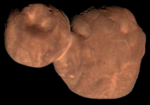astro.wikisort.org - Asteroid
2019 OU1[lower-alpha 1] is a sub-kilometre asteroid, classified as a near-Earth object of the Apollo group.[1][2] On 28 August 2019, the object safely passed 1.028 million kilometres from Earth,[3] travelling at around 13 km/s (47,000 km/h).[2]
| Discovery[1] | |
|---|---|
| Discovered by | Pan-STARRS 1 |
| Discovery site | Haleakala Obs. |
| Discovery date | 25 July 2019 (first observed) |
| Designations | |
MPC designation | 2019 OU1 |
Minor planet category | Apollo · NEO [1][2] |
| Orbital characteristics[1][2] | |
| Epoch 27 April 2019 (JD 2458600.5) | |
| Uncertainty parameter 6[2] · 7[1] | |
| Aphelion | 3.673 au |
| Perihelion | 0.5748 au |
Semi-major axis | 2.2679 au |
| Eccentricity | 0.61977 |
Orbital period (sidereal) | 3.42 years |
Mean anomaly | 313.73° |
Mean motion | 0° 17m 18.916s / day |
| Inclination | 2.2176° |
Longitude of ascending node | 145.143° |
Argument of perihelion | 241.08° |
| Earth MOID | 0.0062 au (2.4 LD) |
| Jupiter MOID | 1.79 au |
| Physical characteristics | |
Mean diameter | 71 m[3] (est. at 0.25)[4] 160 m[5] (est. at 0.05)[4] |
Absolute magnitude (H) | 22.87[2] |
Observation
2019 OU1 was first observed on 25 July 2019 by Pan-STARRS 1 at Haleakala Observatory, Hawaii, United States.[1]
Orbit and classification
2019 OU1 is classified as an Apollo asteroid, which means that it is an Earth-crossing asteroid that has an orbital semi-major axis greater than 1 au but a perihelion distance less than Earth's aphelion distance of 1.017 au.[6]
Close approach in 2019
On 28 August 2019, 2019 OU1 safely passed 0.00687 astronomical units (1.028 million kilometres; 2.67 lunar distances) from Earth,[3] travelling at around 13 km/s (47,000 km/h).[2]
Physical characteristics
Based on its absolute magnitude of 22.874,[1] 2019 OU1 is estimated to have a diameter of 71–160 metres[5] using an assumed albedo of 0.05 (carbonaceous) and 0.25 (siliceous) respectively.[4]
See also
Notes
- The name 2019 OU1 is its provisional designation which is based on the date it was discovered: 2019 for the year, "O" for half-month of 16–31 July, and "U1" for the 21st discovery in the 1st reiteration of the alphabet (excluding "I"), making it the 45th object discovered in the second half of July 2019.
References
- "IAU Minor Planet Center – 2019 OU1". MinorPlanetCenter.net. Retrieved 13 August 2019.
- "JPL Small-Body Database Browser". ssd.jpl.nasa.gov. Retrieved 13 August 2019.
- Mathur, Natasha (12 August 2019). "Asteroid Alert! Giant Asteroid 2019 OU1 To Zoom Past Earth This Month". Mashable India. Retrieved 13 August 2019.
- "Asteroid Size Estimator". cneos.jpl.nasa.gov. Retrieved 13 August 2019.
- Ciaccia, Chris (12 August 2019). "Asteroid the size of the Washington Monument will fly past Earth this month". Fox News. Retrieved 13 August 2019.
- "NEO Basics – Potentially Hazardous Asteroids (PHAs)". CNEOS NASA/JPL. Retrieved 7 August 2019.
External links
- MPEC 2009-O111 : 2019 OU1, Minor Planet Electronic Circular
- List Of Apollo Minor Planets (by designation), Minor Planet Center
- 2019 OU1 at NeoDyS-2, Near Earth Objects—Dynamic Site
- Ephemeris · Obs prediction · Orbital info · MOID · Proper elements · Obs info · Close · Physical info · NEOCC
- 2019 OU1 at ESA–space situational awareness
- 2019 OU1 at the JPL Small-Body Database
Другой контент может иметь иную лицензию. Перед использованием материалов сайта WikiSort.org внимательно изучите правила лицензирования конкретных элементов наполнения сайта.
WikiSort.org - проект по пересортировке и дополнению контента Википедии


